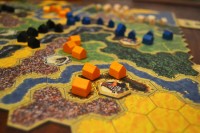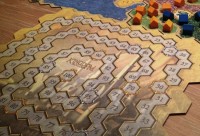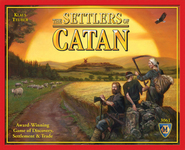Kingdom Builder – a top notch family board game

Kingdom Builder is a great family board game. It’s simple to learn and play, has cool components, and has a good balance of strategy and luck. With the variable boards and random selection of objective cards, every game is different.
If you’re looking for a family board game that’s fun for the whole family, then we think Kingdom Builder, from Queen Games, is what you’re looking for.
We’ve written about Kingdom Builder many times this year because it’s such a great family board game. We’re not surprised at all that it won the Spiel des Jahres (Game of the Year) for 2011.
So we’re very happy to finally post our review of Kingdom Builder!
Can the whole family enjoy Kingdom Builder?

Absolutely!
Even though the recommended ages on the game box list 8+, we think younger kids can enjoy it as well. While they might not deal with the strategic elements of the game, they’ll love matching the terrain cards to the areas on the board where they can place their settlements. They’ll love seeing their settlement areas grow. It’s great to look at the game board at the end and see what you’ve built.
Older kids and adults will enjoy the strategic elements of Kingdom Builder. They’ll love figuring out the best locations to place settlements, how to best combine the special abilities to achieve the scoring objectives, and working to thwart opponents at the same time.
It’s a board game with simple rules for a base that get enhanced as you play it out.
Do your best

Doing well in Kingdom Builder is all about doing the best you can with what you’re given. Like many great family board games, Kingdom Builder has a good bit of luck involved. Where you can place your settlements is driven primarily by the terrain card you draw each turn. So even if you have great plans of where you’d like to play your pieces, you’re going to feel limited with the terrain options you’re presented.
Yes, that may cause some frustration. But that’s also why it’s such a great board game that prompts players to play again and again. And it’s great for families because it helps balance the opportunity for winning amongst the players.
But luck is only part of the game.
Figuring out how to use the terrain card that you’ve drawn is where the strategic elements come into play. Claiming and using the special abilities on each board is also key to implementing a good strategy. Those abilities are what allow players to manipulate the basic rules of the game to their advantage.
Improve their thinking

Because of these elements, Kingdom Builder is also a great board game for helping your kids learn how to think through their strategic options.
At first they may just love placing pieces. But as your kids play Kingdom Builder, they’ll begin to see these strategic elements emerge. And they’ll gain confidence as they learn to use their thinking to develop basic strategies.
Caleb, our youngest, has won a number of games but they haven’t been just because of luck. He’s made some good strategic moves at the right moment like blocking others from getting to certain spots or monopolizing certain areas.
Love the variability
The other thing that makes Kingdom Builder such a great game is the variability. We love the random selection of how you score points in the game. Every time you play, you’ll have different objectives to complete. One time you may be trying to build the biggest group of settlements and in another game you may want them spread out as much as possible.
In addition to the variable goals, the variable set up of the boards provides a new combination of terrain layout and special abilities that you can gain during every game. With all these variable set up options, there’s plenty of replayability in Kingdom Builder.
Perfect play time

On the box you’ll notice that play time is listed as 45 minutes. But we don’t’ see games lasting that long.
Because you have to place 3 settlements every turn and every player has 40 settlement pieces, the longest the game will go is 13 rounds. Most likely it will end before that because players will gain special abilities that allow them to place additional settlements on their turn. And once players have the simple mechanics of play down, each turn goes rather quickly. So even in a 4 player game, the total time is less than 30 minutes.
And even at 30 minutes, the time goes by very quickly. There’s something inherently fun about watching a countryside develop before your eyes (that’s what we love about Carcassonne too). Because players are actively engaged in making that development happen, the time always seems to fly by.
Mitigate any downsides

Depending on how you like to play, you may encounter some downsides. If you’re a pure strategist, you may be frustrated with the luck of the terrain card draws. The complaint we hear most often is the terrain card draw at the start of the game. Where you place your pieces on your first turn will have a big impact on your strategy and where you can advance on subsequent turns. So that first card draw can seem very limiting.
But this is an easy fix. If this frustrates you, just make a house rule that every player draws 2 terrain cards to being the game and can choose which one to use first. This let’s players have a better view at their first two turns for setting up their strategy.

And if you want to add even more strategy to the game to almost eliminate the luck element of the card draw, simply have each player keep 2 cards in their hand throughout the whole game. That way you’ll have additional options of where to play each turn. The only downside to this alteration is that it might slow the game down a bit, but not much.
The other element that can cause some consternation are the random 3 objectives at the start of the game that set out the scoring and win conditions. At times you may draw 2 cards that seem at odds. For example, if you draw the objective that gives you points for the largest group of your settlements plus the objective that gives points for separated settlement areas, they don’t work great together.
However, this is an easy fix because you can simply pick another objective card to replace one of the offending goals. Or you can just suck it up and play it out to see which way everyone chooses to approach the goals. We think it makes for interesting games.
Add some color

Our last bit of advice is to paint the brown settlements another color. We don’t know why they didn’t come painted, because the blue and orange pieces look great. We’ll even give the black pieces a break and say they’re fine. But those brown pieces are just way too plain.
Of course, that’s also very simple to remedy with some paint. I think our brown pieces are about to turn red!
How does Kingdom Builder score on our “Let’s Play Again” game meter?
Kingdom Builder scores very high on our “let’s play again” game meter. As we’ve already mentioned, the amount of variability in the game set up means that every game will be different. And the balance of luck and strategy is just right for a family board game and lends itself well to rematches and playing again and again.
We highly recommend Kingdom Builder to families everywhere.
P.S. There are also some variants that have been posted on BoardGameGeek that will mix it up. The one we’re going to try is selecting 1 objective for everyone and each person gets their own 2 that they keep secret. Should make for some fun end-game scoring.
| The Board Game Family Game Ratings | |
| Caleb | |
| Has not played | Brooke |
| Jaden | |
| Trevor | |
| Mom | |
| Dad | |
| Average | |
| Pick up a copy! |



What! Red?! I thought you all bled blue! On principle you can’t go with red. Paint them green. 🙂
So true! Thanks for stopping us before such a travesty.
Besides, if you ever want to get the Nomads expansion, I believe it includes a set of settlements for a 5th player that are red, so you may end up with two red sets.
Sam – you’re right. Nomads does come with Red for a 5th player. Looks like it will be green or yellow.